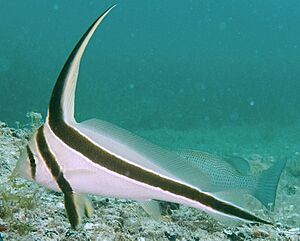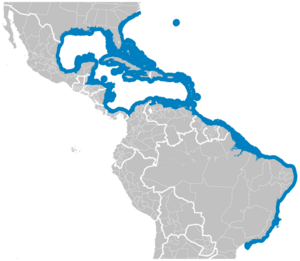Jack-knifefish facts for kids
Quick facts for kids Jack-knifefish |
|
|---|---|
 |
|
| Conservation status | |
| Scientific classification | |
 |
|
| Jack-knifefish range. | |
| Synonyms | |
|
The jack-knifefish (Eques lanceolatus) is a cool-looking marine fish. It belongs to the family of drums and croakers, known as Sciaenidae. You can find this fish in the western Atlantic Ocean.
Its home stretches along the eastern coasts of the Americas. This includes areas from the Carolinas in the United States all the way down to Brazil. It also lives throughout the Caribbean Sea. People sometimes call it the donkey fish or lance-shaped ribbonfish because of its unique shape.
Contents
About Its Name
The jack-knifefish got its first official name, Chaetodon lanceolatus, in 1758. A famous scientist named Carl Linnaeus described it in his book, Systema Naturae.
Later, in 1793, another scientist named Marcus Elieser Bloch gave it a new name, Eques americanus. The name Eques lanceolatus is now the one most commonly used for this fish.
What Does It Look Like?
This fish can grow to about 25 centimeters long. That's about the length of a standard ruler! It has a very tall first dorsal fin on its back.
The jack-knifefish is gray in color. It has three brown or black stripes on its body. The first two stripes are small and go up and down. The third stripe is longer. It starts from the tip of the tall dorsal fin and goes all the way down to the tip of its tail fin.
Where Does It Live?
This marine fish mostly lives along coasts. You can find it in waters up to 60 meters deep. It especially likes to live in coral reef areas.
What Does It Eat?
The jack-knifefish enjoys eating small invertebrates. These are tiny creatures without backbones, like small crabs or worms. Sometimes, it also eats detritus, which is bits of dead plants and animals.
Jack-knifefish as Pets
Some people like to keep the jack-knifefish in their marine aquariums. It's a popular choice because of its interesting look. This species can even be bred in captivity, meaning they can have babies in a fish tank.
Is the Jack-knifefish Endangered?
No, this species is not considered to be in danger. The aquarium trade, where fish are collected for pets, does not harm its populations much. This is true even though it's easy to catch from the wild. The jack-knifefish lives in many places and is a common species in its habitat.


